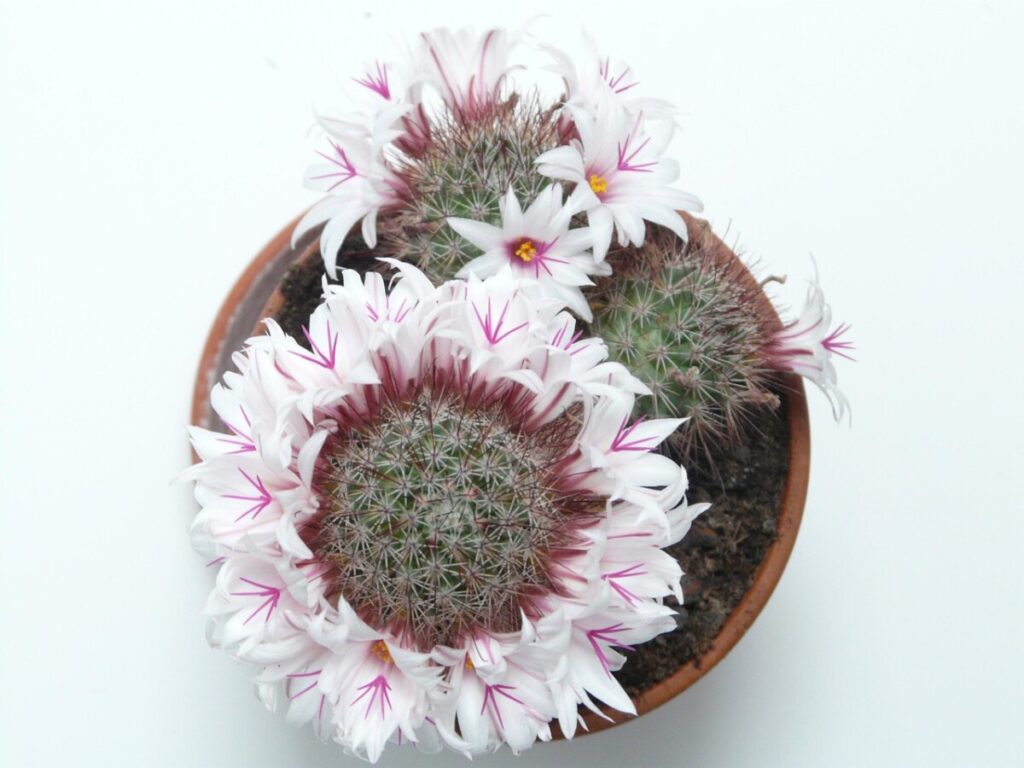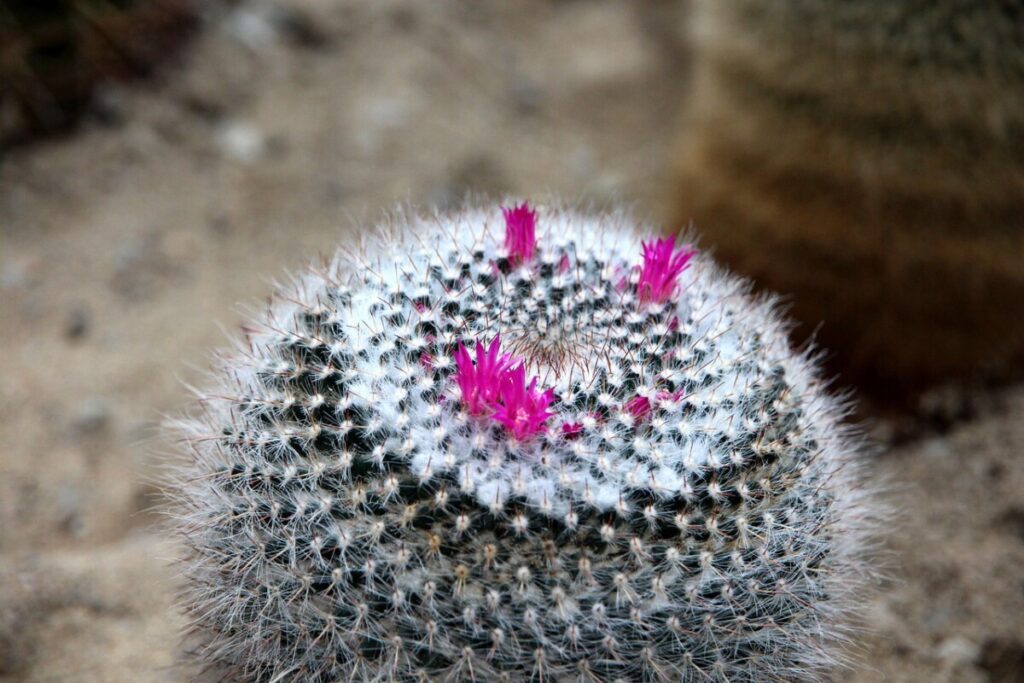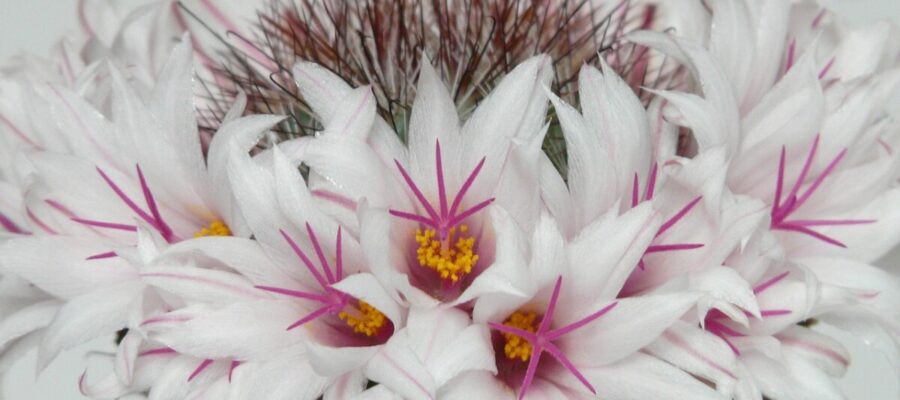Scientific name: Mammillaria Bombycina
Family: Cactaceae
Category: Cactus and fatty plants, foliage
Climate: Continental, equatorial, Mediterranean, semi-arid, tropical
Origin: North America, Mexico
Height: Less than 15 cm
Brightness: Widespread light, half shadow, full sun
Vital cycle: perennial
A Mammillaria Bombycina It is a kind of cactus that belongs to the family CactaceaeOriginally from the arid and semi -arid regions of Mexico. Recognized for its peculiar appearance and vibrant flowers, this succulent plant has conquered the heart of gardeners and cactus collectors all over the world.
Its main feature is the coverage of thin and soft hair that cover the tubers, providing a velvety consistency that is both fascinating and unique.
Features of Mammillaria Bombycina
A Mammillaria Bombycina It is a small plant with a compact and globular structure. In general, this cactus does not exceed 30 cm in height, but can expand in width, creating a rounded or slightly conical shape.
Its form and compact growth make it ideal for cultivation in pots, gardeners or even cactus agreements. The plant develops slowly, but with adequate exposure to light and the necessary care, it can become a nice addition to any environment.
The most surprising feature of Mammillaria Bombycina is his Fine and soft hair coverage. These hair cover the tubers (the small protuberances that make up the cactus) and give it a velvety appearance, almost like a natural «plush».
Although the plant has thorns, they are usually small and less evident than other species of cactus. Instead of long and pointed thorns, the mammellar bombycin has spine, yellow or white, which are at the center of the tubers and can be difficult to make due to the «covered» of the hair.
The flowers of Mammillaria Bombycina They are another of their main attractions. When the plant reaches maturity, usually during spring and summer, it begins to produce small flowers that appear on a ring around the top of the cactus.
The flowers are delicate and a vibrant color, such as pink, red or white, with more saturated tones that make a good contrast with the soft green of the plant. These flowers attract pollinators such as bees and butterflies, helping to promote local biodiversity.
After flowering, the bombycin mammular can produce spherical fruits that become red as they ripen. Although these fruits are not edible because of their acid and bitter taste, they serve food for some birds, which feed on small fruits.
The plant can also propagate through these seeds, although the propagation by division or batteries is more common.

How to cultivate and take care of the mammellar bombycin
A Mammillaria Bombycina It is an easy cultivation and maintenance plant, especially for those who already have a certain experience with cactus and fatty plants. Although resistant, the plant requires some specific conditions to develop in a healthy way and thrive in a lush way.
Here are some essential tips to cultivate Mammillaria Bombycina.
1. Location and exposure to the sun
Since the bombycin mammal is originally from arid regions, loves intense sunlight. Because the plant grows strong and prosperous in abundance, it needs at least 4-6 hours of direct sunlight every day. This cactus thrives in hot and dry climates and exposure to sunlight helps to stimulate the process of photosynthesis, vital for the health of plants.
In internal environments, the breast bombycin should be placed near a sunny window, preferably to the south or west. If cultivated outdoors, it should be planted in a place where you receive direct light, like a garden or a porch.
However, during excessive heat periods, the plant can be partially shaded during the most intense time of light, especially if the climate is too hot.
2. Soil and drainage
One of the main needs of the Mammlare bombycin is a well -drained soil. Since the plant is adapted to the dry regions, it does not tolerate the soaked land. The soil should be sandy and porous, which allows water to drain quickly, preventing the roots from being immersed in water for a long time.
A good option to cultivate mammellar bombycin is the use of a specific soil mixture for cactus and fatty plants. If you prefer to prepare the ground at home, you can mix the earth for vases, sand and perlite or small stones, ensuring efficient drainage.
Em shipIt is important to ensure that the container has holes on the bottom to allow the excess exit of water.
3. Rega
Mammlare Bombycin is a drought tolerant plant, which means that it does not need frequent watering. During the summer, it is recommended to water the plant once a week, but always check the humidity of the soil before irrigation.
The soil should be completely dry between irrigation, since excess water can cause radical rot and damage the health of the plant.
In winter, irrigation should be reduced even more, as the plant enters a period of dormant. During this period, the Mammlare Bombycin does not need frequent irrigation and, in many cases, a monthly irrigation may be sufficient.
In internal environments, where air humidity can be more constant, the plant may need even less water.

4. Temperature
A Mammillaria Bombycina It prefers hot temperatures and should be grown in environments where the temperature varies between 20 ° C and 30 ° C. In the colder climatic regions, the plant can be grown in pots to be brought to the house during the coldest months.
In Mammillaria Bombycina No frost toleraAnd temperatures below 5 ° C can damage the plant, causing irreparable damage.
5. Fertilization
Although Mammlare bombycin does not require frequent fertilization, it can benefit from a small nutritional stimulus during the growth station. A balanced, diluted, specific, cactus and succulent fertilizer can be used.
Ferteying must be performed every 4-6 weeks during spring and summer. In winter, when the plant enters numbness, fertilization should be suspended.
Further treatments
While Mammillaria Bombycina Be relatively easy to cultivate, there are some additional considerations that can help to guarantee your healthy growth.
- Parasites and diseases: The mammellar bombycin is resistant to many parasites, but can be influenced by sprouts and aphids, especially if grown inside or with little ventilation. The application of natural insecticides, such as Neem oil, can help control these problems.
- Pruning: Pruning is not essential for this plant, but it can be useful for removing damaged or dry parts. This can help keep the plant healthy and promote the growth of new shoots.
- Replanting: If the mammellar bombycin is grown in a small vase, it may be necessary to replant in a larger ship as it grows. This will ensure that the roots have enough space to expand.
Conclusion
A Mammillaria Bombycina It is an attractive succulent plant, easy to – -cultivated and low maintenance, ideal for beginner gardeners or for those looking for an exotic plant to be added to their space.
Its velvety consistency and vibrant flowers make it an excellent option for decoration, in the internal or outdoor gardens. With adequate cure, this plant can thrive for many years, bringing beauty and a tropical touch to any environment.

How to cook winter radishes?

FLOWER CLOVE-MARITIMA ARMERIA: Cultivation and care

The importance of bees for pollination

The final guide on how to plant, take care and discover the origin of Coleonema

The wisdom of the garden: the influence of popular proverbs on the plantation and the care of natural flowers

Let's discover the rose and its secrets: the May plant

Friar Kiss – Balsamin Family

Amarilis – Learn to take care (Hippeastrum Hybridum)

CHANTRIERI NOC – The bat flower has flowers resemble the bats


